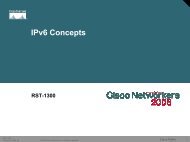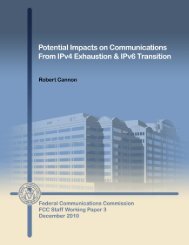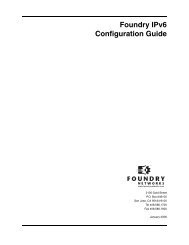IPv6 Security
IPv6 Security
IPv6 Security
You also want an ePaper? Increase the reach of your titles
YUMPU automatically turns print PDFs into web optimized ePapers that Google loves.
122 Chapter 3: <strong>IPv6</strong> Internet <strong>Security</strong>transition to using a shim. Packet filters also need to be aware of session state when theULIDs change within the shim.Currently discussions are ongoing within the IETF about the use of shim6 and how itimpacts other aspects of the <strong>IPv6</strong> protocol and the operations of an <strong>IPv6</strong> network. There areonly a couple of implementations for hosts. There are discussions about integrating thisfunctionality into routers so that they can perform this process on behalf of devices that donot have sufficient resources to create the shim themselves. There is also discussion abouthow the shim could be used for traffic engineering purposes instead of a simplemultihoming solution. For the most updated information on this topic, you can go to theshim6 IETF working group site at http://www.ietf.org/html.charters/shim6-charter.html.SummaryThere will be many large-scale Internet threats that plague the <strong>IPv6</strong> Internet in just the sameway as DoS attacks disrupt today’s Internet. Hopefully the larger address space of <strong>IPv6</strong> willmake scanning worms a thing of the past; however, other types of worms are likely toevolve. If service providers and customer organizations are performing ingress and egressfiltering, tracebacks will be easier. The more research done on these <strong>IPv6</strong> Internet threats,the more secure the <strong>IPv6</strong> Internet will be in the future.Service providers might be hesitant to add <strong>IPv6</strong> functionality to their production IPv4networks. They have a fear that new <strong>IPv6</strong> vulnerabilities will lead to instability of theirrevenue-generating IPv4 networks. Network service providers can leverage secure BGPpeering to help make the Internet a safer place for all. If service providers perform theproper filtering, they can mitigate many of these risks. Many organizations are connectingto dual-stack services today, and service providers can leverage their existing MPLSinfrastructures to create secure <strong>IPv6</strong> services.The key is to make the customers’ experience transparent, which means making it easy forthem to configure their devices and securely automate address assignments. However,customers will have the same demands of <strong>IPv6</strong> Internet connectivity as they have with IPv4Internet connectivity. That means that solutions to <strong>IPv6</strong> multihoming will need to bedeveloped and secured.ReferencesAfriNIC. ftp://ftp.afrinic.net/pub/stats/afrinic/delegated-afrinic-latest.APNIC. http://ftp.apnic.net/stats/apnic/delegated-apnic-latest.ARIN. ftp://ftp.arin.net/pub/stats/arin/delegated-arin-latest.
















